Resources
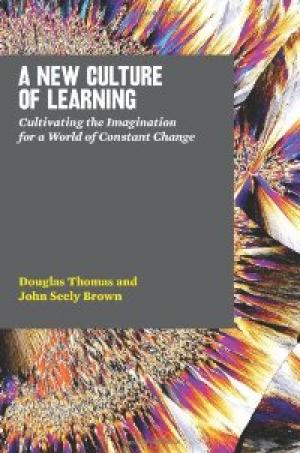
The twenty-first century is a world in constant change. In A New Culture of Learning, Doug Thomas and John Seely Brown pursue an understanding of how the forces of change, and emerging waves of interest associated with these forces, inspire and invite us to imagine a future of learning that is as powerful as it is optimistic. Typically, when we think of culture, we think of an existing, stable entity that changes and evolves over long periods of time. In A New Culture, Thomas and Brown explore a second sense of culture, one that responds to its surroundings organically. It not only adapts, it integrates change into its process as one of its environmental variables. By exploring play, innovation, and the cultivation of the imagination as cornerstones of learning, the authors create a vision of learning for the future that is achievable, scalable and one that grows along with the technology that fosters it and the people who engage with it. The result is a new form of culture in which knowledge is seen as fluid and evolving, the personal is both enhanced and refined in relation to the collective, and the ability to manage, negotiate and participate in the world is governed by the play of the imagination. Replete with stories, this is a book that looks at the challenges that our education and learning environments face in a fresh way. (From the Publisher)
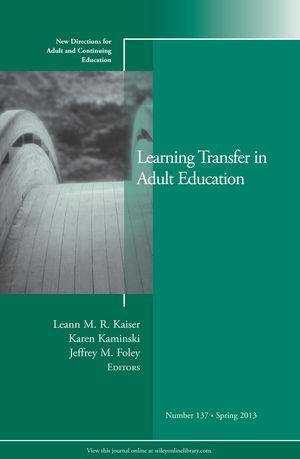
Click Here for Book Review Abstract: Learning transfer is the use of skills and knowledge acquired in one situation or setting in a different environment. It is, fundamentally, the point of education. By consciously building it into our curricula, syllabi, and practice, we can greatly enhance the likelihood that students will integrate their learning and their lives. This issue examines learning transfer across the breadth of adult education. The authors approach the question practically, looking at techniques such as experiential or problem-based learning and the use of classroom technology as well as the perspectives of brain research, the effects of race and culture, and the context and complications of personal change. Each chapter offers practitioners a thoughtful outlook that will help them plan for and implement learning transfer in their particular area of focus. This is 137th volume of the Jossey-Bass quarterly report series New Directions for Adult and Continuing Education. Noted for its depth of coverage, it explores issues of common interest to instructors, administrators, counselors, and policymakers in a broad range of adult and continuing education settings, such as colleges and universities, extension programs, businesses, libraries, and museums. (From the Publisher)
Three substantial pages, well-researched, and accessible. The site seeks to link student thinking, learning and performance in a peer tutoring program. Provided by the Learnwell Projects.
University of Minnesota Resources to support active learning classrooms (ALCs), defined as student-centered, technology-rich classrooms.
Information, advice, examples of best practices, and inspiration to those using or thinking about using learning environments known as "Active Learning Classrooms" (ALCs). Produced by the University of Minnesota’s Center for Teaching and Learning. Both concrete and grounded in theory of active learning. Also has an annotated bibliography.
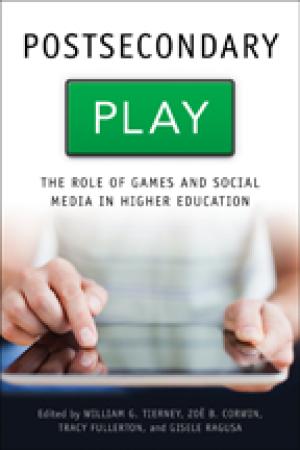
The college application process—which entails multiple forms, essays, test scores, and deadlines—can be intimidating. For students without substantial school and family support, the complexity of this process can become a barrier to access. William G. Tierney and his team at the University of Southern California approach this challenge innovatively. Using the tools of online games and social media, they have developed ways to make applying for college much less intimidating. While the vast majority of college students use social media and gaming in their everyday lives, colleges and universities have been slow to recognize and harness the power of either. Postsecondary Play explores the significance of games and social media in higher education, and particularly how they can be used to attract, retain, educate, and socialize students. Tierney, a past president of the American Educational Research Association, has gathered some of the best research on the emerging role of multiplayer games in the classroom and how these tools can boost student confidence and increase college access. Scholars writing from a wide variety of disciplines—college access, social media, game studies, and learning sciences—provide concrete examples to illustrate the new and complex ways in which students learn in response to social media and games. Tierney and the contributors find that, although games can be powerful tools for encouraging underserved students, quality game design and mastering the concept of play—the ability to develop skills while engaging in the game—are essential in the effective use of serious games in teaching and learning. Summarizing a decade of research in game design and learning, Postsecondary Play will appeal to higher education scholars and students of learning, online gaming, education, and the media. (From the Publisher)
A 300 page free-download e-book on the interplay between the science of learning, the science of instruction, and the science of assessment. Research on how people learn is applied to educational settings. The book is based on theory and research in cognitive psychology. (Excerpted from the Introduction.)
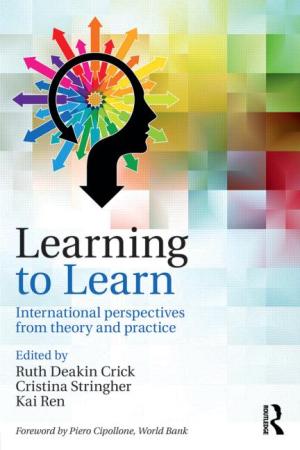
Click Here for Book Review Abstract: Learning to Learn provides a much needed overview and international guide to the field of learning to learn from a multidisciplinary lifelong and lifewide perspective. A wealth of research has been flourishing on this key educational goal in recent years. Internationally, it is considered to be one of the key competencies needed to compete in the global economy, but also a crucial factor for individual and social well-being. This book draws on leading international contributors to provide a cutting-edge overview of current thinking on learning to learn research, policy, and implementation in both formal and informal learning environments. But what learning to learn is exactly, and what its constituting elements are, are much debated issues. These seem to be the crucial questions if assessment and development of this 'malleable side of intelligence' are to be accomplished. The approach of this volume is to consider a broad conception of learning to learn, not confined to only study strategies or metacognition, yet acknowledging the importance of such elements. The book sets out to answer five main questions: • What is learning to learn? • What are its functions and how do we assess it? • What does it promise to the individual and society at large? • How is it conceived in national curricula internationally? • How can it be developed in a variety of contexts? The text is organized into two parts: the first addresses the core question of the nature of learning to learn from a theoretical and policy viewpoint, and the second presents recent research carried out in several educational systems, with special attention to assessment and curriculum. It gives an account of pedagogical practices of learning to learn and its role in individual empowerment from childhood to adulthood. Contributors also highlight the potential use of learning to learn as an organizing concept for lifelong learning, school improvement, and teacher training along with potential conflicts with existing incentive practices and policies. This book is a vital starting point and guide for any advanced student or researcher looking to understand this important area of research. (From the Publisher)
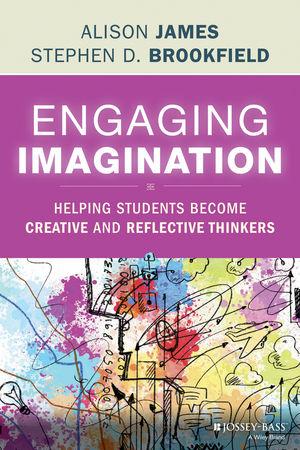
Click Here for Book Review Abstract: How to nurture creativity in tomorrow’s innovators—today’s college students When asked what they want colleges to emphasize most, employers didn’t put science, computing, math, or business management first. According to AAC&U’s 2013 employer survey, 95% of employers give hiring preference to college graduates with skills that will enable them to contribute to innovation in the workplace. In Engaging Imagination: Helping Students Become Creative and Reflective Thinkers, two leading educators help college instructors across disciplines engage students in nurturing creativity and innovation for success beyond the classroom. Alison James, an expert in creative arts education, and Stephen D. Brookfield, bestselling author, outline how creative exploration can extend students’ reflective capabilities in a purposeful way, help them understand their own potential and learning more clearly, and imbue students with the freedom to generate and explore new questions. This book: • shows why building creative skills pays dividends in the classroom and in students’ professional lives long after graduation; • offers research-based, classroom-tested approaches to cultivating creativity and innovation in the college setting; • provides practical tools for incorporating “play” into the college curriculum; • draws on recent advances in the corporate sector where creative approaches have been adopted to reinvigorate thinking and problem-solving processes; and • includes examples from a variety of disciplines and settings. Engaging Imagination is for college and university faculty who need to prepare students for the real challenges of tomorrow’s workplace. (From the Publisher)
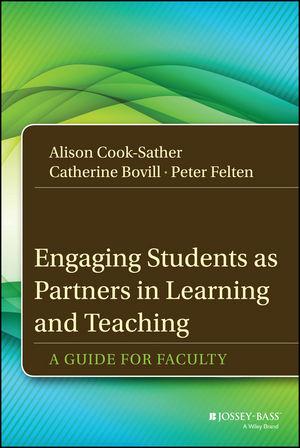
A guide to developing productive student-faculty partnerships in higher education Student-faculty partnerships is an innovation that is gaining traction on campuses across the country. There are few established models in this new endeavor, however. Engaging Students as Partners in Learning and Teaching: A Guide for Faculty offers administrators, faculty, and students both the theoretical grounding and practical guidelines needed to develop student-faculty partnerships that affirm and improve teaching and learning in higher education. • Provides theory and evidence to support new efforts in student-faculty partnerships • Describes various models for creating and supporting such partnerships • Helps faculty overcome some of the perceived barriers to student-faculty partnerships • Suggests a range of possible levels of partnership that might be appropriate in different circumstances • Includes helpful responses to a range of questions as well as advice from faculty, students, and administrators who have hands-on experience with partnership programs Balancing theory, step-by-step guidelines, expert advice, and practitioner experience, this book is a comprehensive why- and how-to handbook for developing a successful student-faculty partnership program. (From the Publisher)